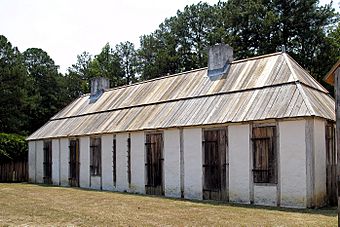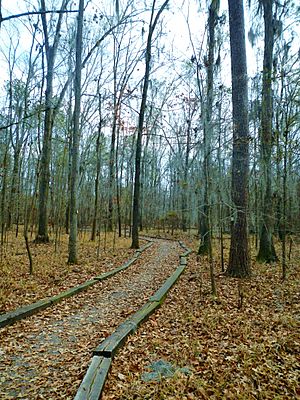Fort Toulouse and Fort Jackson facts for kids
|
Fort Toulouse Site-Fort Jackson
|
|

A portion of the modern Fort Toulouse reconstruction, taken in 2007.
|
|
| Nearest city | Wetumpka, Alabama |
|---|---|
| Built | 1814 |
| NRHP reference No. | 66000148 |
Quick facts for kids Significant dates |
|
| Added to NRHP | October 15, 1966 |
| Designated NHL | October 9, 1960 |
Fort Toulouse and Fort Jackson are two important forts that stood on the same spot in Alabama. This special place is where the Coosa River and the Tallapoosa River meet, close to a town called Wetumpka, Alabama. These forts played a big role in the history of the area, showing how different groups of people lived, traded, and sometimes fought there.
Contents
Exploring Fort Toulouse and Fort Jackson
This historic site tells the story of French, Native American, and American people. It helps us understand how the land and its people changed over hundreds of years.
Fort Toulouse: A French Outpost in Alabama
Fort Toulouse was built by the French in 1717. They also called it Fort des Alibamons. The fort was named after a French count, Louis-Alexandre de Bourbon, comte de Toulouse. The French wanted to stop the British from gaining too much power in the area. This fort was on the eastern edge of the French territory called Louisiana.
The fort was also known as the "Post of the Alabama." This name came from the Alabama tribe. They were a group of Upper Creek Indians who lived nearby. Their homes were just below where the Coosa and Tallapoosa rivers joined to form the Alabama River.
Life and Trade at Fort Toulouse
About 20 to 50 French soldiers, called Colonial Marines, lived and worked at Fort Toulouse. They traded many things with the local Creek Native Americans. The French offered European goods like Flintlock guns, gunpowder, iron tools, and glass beads. In return, they received food, animal furs, and deerskins.
These trades helped build friendly relationships. A French commander, Captain Jean Baptiste Louis DeCourtel Marchand, even married a high-status Creek woman named Sehoy around 1720. Their family line later included important Creek chiefs like Alexander McGillivray and William Weatherford. These chiefs inherited their leadership from their mothers' families, which was a Creek tradition.
Challenges and Changes for the French Fort
Life at the fort was not always easy. The French government sometimes neglected the fort, leading to poor living conditions. In 1722, some soldiers even rebelled. They killed their captain and tied up other officers before leaving. Luckily, the officers escaped and, with help from the Creek people, caught the rebellious soldiers.
In 1735, the British built their own fort, Fort Okfuskee, further up the Tallapoosa River. They wanted to compete with the French for trade. The French governor of Louisiana, Pierre de Rigaud, tried to stop the Creek tribes from helping the British. He warned them that the French would stop trading if they did.
By the 1740s, things got better at Fort Toulouse. Many soldiers had married French women or local Creek women. They started farms nearby, which meant more food. However, the humid weather caused the fort to wear down. So, around 1751, the French rebuilt Fort Toulouse for a third time. This project was very expensive for the Louisiana colony.
The French and Indian War ended in 1763 with the Treaty of Paris. The French lost the war and had to give their land to the British. The French soldiers at Fort Toulouse disabled their cannons and left. The British decided not to use the fort, and it slowly fell apart. Later, in 1776, a naturalist named William Bartram visited the area to study plants and animals.
Fort Jackson: An American Stronghold
During the War of 1812, a conflict broke out among the Creek Nation in 1813. This led to American forces, led by General Andrew Jackson, invading the area. In the Creek War of 1813–1814, General Jackson and his soldiers, along with Cherokee and Creek allies, defeated the Red Stick Creeks at the Battle of Horseshoe Bend.
After this victory, Jackson ordered a new fort to be built on the same spot as the old French fort. This new fort was near a sacred Creek site called the Hickory Ground. While Jackson was away, the fort was named "Jackson" in his honor. When he returned, he made both his Creek allies and enemies sign the Treaty of Fort Jackson. This treaty took away 20 million acres of land from all Creeks for white settlers.
The site of Fort Toulouse and Fort Jackson was recognized as a National Historic Landmark in 1960. In the 1970s, during America's 200th birthday celebrations, people tried to rebuild Fort Toulouse. But they accidentally built it on the larger outline of Fort Jackson instead of the original French fort.
Visiting the Fort Toulouse-Fort Jackson Historic Site
Today, the Fort Toulouse-Fort Jackson State Historic Site is managed by the Alabama Historical Commission. In the 1980s, they carefully took down the incorrectly built fort. Then, they built a correct replica of Fort Toulouse closer to its original location. This allows for a future reconstruction of Fort Jackson on its actual site.
Archaeologists from Auburn University at Montgomery, led by Dr. Craig Sheldon, continue to dig and learn more about the site. The historic site offers "living history" programs. These programs help visitors understand what life was like for the Creek people, French colonists, and American soldiers during the War of 1812. You can find the fort southwest of Wetumpka, off U.S. Highway 231.
Discovering Ancient History at Taskigi Mound
The site also includes the Taskigi Mound. This is a very old village from the South Appalachian Mississippian culture. It had a fence-like wall, a central open area, and a rectangular mound. The Taskigi Mound is part of the "Alabama Indigenous Mound Trail" from the University of Alabama Museums. It helps us learn about the ancient people who lived here long ago.
Nature and History at the William Bartram Arboretum
The William Bartram Arboretum is also located at the historic site. It's a special garden with many different kinds of trees and plants. It's named after the naturalist William Bartram, who visited the area in 1776. The arboretum helps visitors connect with the natural beauty and history of the region.




